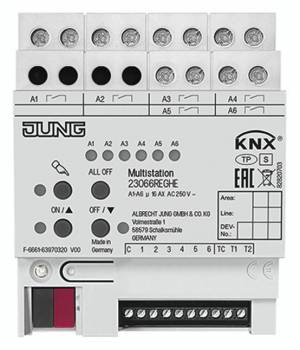JUNG 23066REGHE
Installation > Home Automation > EIB material

JUNG 23066REGHE
| Lieske Part No. | 1352318 |
|---|---|
| Mfg Part No | 23066REGHE |
| EAN-Code | 4011377157620 |
| Manufacturer | JUNG |
| Here only | 233,64 EUR
278,03 EUR incl. VAT
|
Further information for JUNG 23066REGHE
KNX multi-station, logic functions for controlling building functions, actuator functions: switching, blinds and electrothermal drives, actuator function can be switched in pairs, integrated button interface with 6 inputs, 2 integrated room temperature controllers, 2 inputs for temperature sensors (item no. FF 7.8), outputs can be operated manually, feedback in manual mode and in bus mode, scene function, blocking of individual outputs manually or by bus, switching function: maximum 6 switching outputs, normally open or normally closed operation, linking and forced operation function, feedback function, central switching function with collective feedback, time functions: switch-on and switch-off delay and staircase light switch with pre-warning function, blind function: maximum 3 blind outputs, suitable for 230 V AC motors, blind position can be controlled directly, slat position can be controlled directly, feedback of driving status, blind position and slat position, forced position by higher-level control, safety function: 3 independent wind alarms, rain alarm and Frost alarm, sun protection function, actuator function: maximum of 2 outputs for electrothermal drives, switching operation or PWM operation, actuators with the characteristic of being open when de-energized or closed when de-energized can be controlled, emergency operation in the event of a bus failure for summer and winter, protection against stuck valves, forced position, cyclical monitoring of the input signals can be parameterized, heating controller: 2 internal control circuits for controlling 2 independent rooms, control for heating or cooling operation, optionally with additional stage, two-point, PWM or PI control, predefined heating types (hot water heating, fan convector ...) or individual parameters possible, inputs: 6 inputs for buttons, input functions switching, dimming, blind control, light scene extension and brightness or temperature value transmitter, 2 inputs for external temperature sensors, logic functions: up to 10 logic functions with 8 inputs each, e.g. B. for AND, OR and XOR operations, converting data point types, e.g. 1 bit to 8 bits, comparison operations, e.g. , ?, ?, arithmetic functions, e.g. +, ?, *, :, KNX medium: TP 256, KNX nominal voltage: DC 21 to 32 V SELV, KNX current consumption: maximum 20 mA and minimum 4 mA, power loss: maximum 6 W, KNX connection: connection and branch terminal, relay outputs: contact type: potential-free relay contacts (µ-contact), switch type: normally open, switching voltage: AC 250 V ~, minimum switching current AC: 100 mA, switching current AC1 (cos phi > 0.8): 16 A, switching current AC3 (cos phi < 0.8): 16 AX, fluorescent lamps: 16 AX, inrush current 200 µs: maximum 800 A, inrush current 20 ms: maximum 165 A, switching voltage DC: DC 12 to 24 V, switching current DC 24 V: 6 A, connected load 230 V: resistive load: 3000 W, blind/fan motors: 1380 VA, lamp loads 230 V, incandescent lamps: 3000 W, HV halogen lamps: 2500 W, HV LED lamps: maximum 400 W, Tronic transformers: 1500 W, inductive transformers: 1200 VA, fluorescent lamps T5/T8:1000 W (uncompensated), 1160 W / 140 µF (parallel compensated) and 2300 W / 140 µF (duo circuit), compact fluorescent lamps: 1000 W (uncompensated) and 1160 W / 140 µF (parallel compensated), mercury vapor lamps: 1000 W (uncompensated) and 1160 W / 140 µF (parallel compensated), electrothermal actuators: cycle time: minimum 15 minutes, load connections: screw terminals: 0.5 to 4 mm² (single-wire and fine-wire without wire end ferrule) and 0.5 to 2.5 mm² (fine-wire with wire end ferrule), inputs: nominal voltage: DC 3.3 V SELV, signal duration: minimum 100 ms, NO contacts: maximum 50, NC contacts: maximum 50, cable length: maximum 30 m, connection inputs: screw terminals: 0.08 to 1.5 mm² (single-wire), 0.08 to 1 mm² (fine-stranded without wire end ferrule) and 0.14 to 0.5 mm² (fine-stranded with wire end ferrule), ambient temperature: ? 5 to + 45 °C, storage and transport temperature: ? 25 to + 70 °C, width: 72 mm (4 HP), mounting on top hat rail according to DIN EN 60715 in sub-verte

This is an offer of:
79279 Vörstetten
http://industry-electronics.com
Tel. 07666/88499-0
Fax. 07666/88499-111
Diesen Artikel finden Sie unter:
industry-electronics.com/artikel/1352318

Lieske Elektronik e.K.
Reutener Str. 1079279 Vörstetten
http://industry-electronics.com
Tel. 07666/88499-0
Fax. 07666/88499-111
Diesen Artikel finden Sie unter:
industry-electronics.com/artikel/1352318
